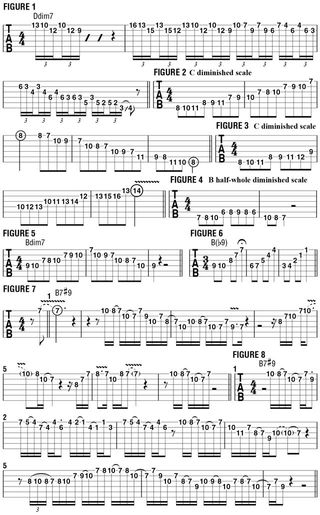Exploring the Diminished Scale with Alex Skolnick
The diminished scale is a highly useful resource for adding spice to solos.

The diminished scale is a highly useful resource for adding spice to solos, creating unique licks and formulating modernist note sequences.
Confusion often stems from the misunderstanding of the term, as it is often misused to describe the type of licks found in FIGURE 1. This arrangement of notes, which fall in minor third intervals, represents a diminished seven arpeggio, which consists of four different notes.
The diminished scale is an eight-note entity, as shown in FIGURE 2. Unlike the modes, the diminished scale is built from a continuously symmetrical intervallic sequence as each four-note group progresses. It’s formula follows an alternating pattern of whole steps and half steps—whole, half, whole, half—that repeats up to the octave root note, as illustrated in FIGURE 3. Meanwhile, any variation of notes within the diminished scale is movable up and down the neck in minor-third intervals (equal to a three-fret shift on a single string).
The diminished scale is often referred to as “whole-half diminished,” which is how I first learned it, in a scale appendix of the highly recommended Jamey Aebersold jazz play-along series of books and audio recordings. By starting with a half step, followed by alternating whole steps and half steps, we get the sole “mode” of the scale, referred to as “half-whole diminished,” as shown in FIGURES 4 and 5.
Here’s where things get interesting: within the rather sinister-sounding B half-whole diminished scale (B C D D# F F# G# A) lives a rather happy-sounding B major triad (B Ds F#). By blending triadic sounds with other notes from the scale, some very modern and “outside”-sounding patterns can be created. FIGURE 6 offers a relatively simple example, which can be moved up and down the neck in minor thirds. Again, any inherent patterns, whether triads, whole steps, half steps, or any combination thereof, can be sequenced up or down in minor thirds.
FIGURE 7 is an interesting example of such a pattern, played in one position, seventh, and FIGURE 8 is a similar idea that moves up and down the fretboard in minor thirds. Since all of these patterns are movable in minor thirds, this means three more major triads—D, F and Ab—also live within the same B half-whole scale. And since each triad has its own inversions (root position, first and second inversion) the possibilities for melodic invention are immense!
Although I tend to use diminished-scale ideas primarily in improvisational settings, I occasionally sneak one into a metal solo (such as in Testament’s “More Than Meets the Eye” [hear it below]). These types of ideas, by the way, first got my attention via the work of saxophonist Michael Brecker and guitarist John Scofield, both of whom influenced guitarist Jimmy Herring, another big proponent of diminished patterns. Check out their work, keep an ear out for cool-sounding diminished ideas and have fun exploring these concepts on your own.
Alex Skolnick photos from lesson video by Tom Couture | www.tomcouture.com

Get The Pick Newsletter
All the latest guitar news, interviews, lessons, reviews, deals and more, direct to your inbox!

Want to play Master of Puppets the right way? Here's how to get faster at downpicking so you can chug like James Hetfield
![Joe Bonamassa [left] wears a deep blue suit and polka-dotted shirt and plays his green refin Strat; the late Irish blues legend Rory Gallagher [right] screams and inflicts some punishment on his heavily worn number one Stratocaster.](https://cdn.mos.cms.futurecdn.net/cw28h7UBcTVfTLs7p7eiLe-840-80.jpg)
“The intensity of Rory’s guitar playing – the emotion, the sound and his incredible attack – was mindblowing for me”: Joe Bonamassa pays tribute to the late, great Irish blues-rock icon Rory Gallagher









